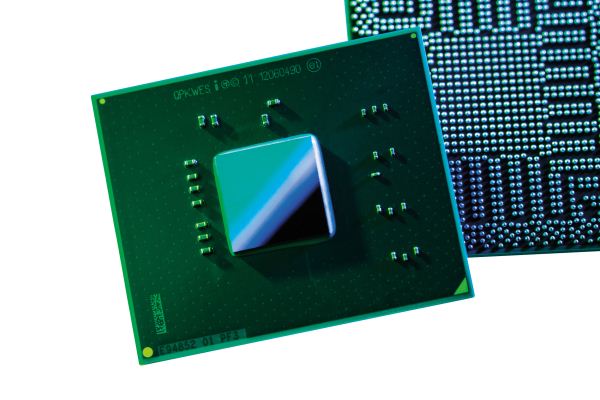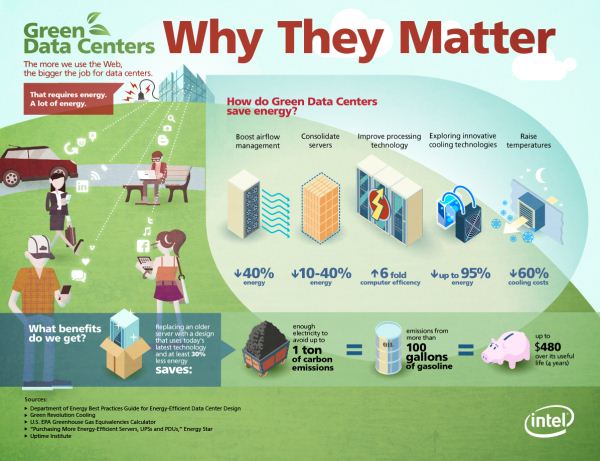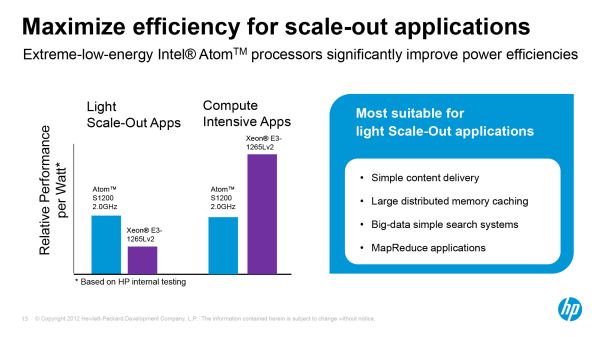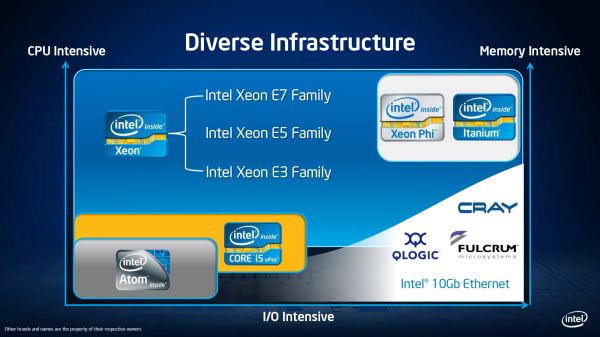Intel Launches “Centerton” Atom S1200 Family, First Atom For Servers
by Ryan Smith on December 11, 2012 10:30 PM EST- Posted in
- CPUs
- Intel
- Atom
- Xeon
- Cloud Computing
In recent months much has been made over the potential incursion of ARM into Intel’s tightly held server markets, and for good reason. ARM’s general focus on SoCs for consumer devices like phones and tablets has treated the company and its partners well over the past few years, but with continued upwards and outwards growth of the ARM ecosystem, ARM and its partners have been looking to expand into new markets. With that in mind they have turned their eyes towards servers, a somewhat small but very lucrative market that offers much greater profitability than the cutthroat consumer space.
ARM’s leading edge partners like Calxeda have already been toying with the concept, creating a new class of microserver based around utilizing many ARM cores to create a high density, highly threaded server with weak per-thread performance but strong overall performance, an ideal setup for shared hosting and other subsets of sever workloads. Of course ARM’s existing 32bit ARMv7 designs can only go so far, leading to ARM taking a more direct shot across Intel’s bow with the announcement of their new 64bit ARMv8 ISA and parts such as Cortex A57. ARM and their partners believe in the potential of the microserver concept, and ARMv8 will be the ISA that lets them seriously chase the concept. But before they can get that far they must face the 800lb gorilla of the server world: Intel.
Intel for their part jealously guards the server market, looking to hold onto those profitable markets that have driven Intel’s own growth and phenomenal profits. Though Intel’s primary focus has continued to be on their Core architecture derived server parts, the company has also indirectly flirted with the concept of microservers, with ex-customer (and now AMD subsidiary) SeaMicro building one of the first server businesses based around Intel’s Atom processors. SeaMicro may be gone now, but Intel has continued to work on the technology, and with ARM drumming up interest in microservers ahead of their entrance to the market next year, Intel will be making the first move.
To that end, today Intel is launching the Atom S1200 series, Intel’s first Atom processors designed specifically for the server market. Previously going by the codename Centerton, the Atom S1200 series is based around Intel’s existing 32nm Saltwell architecture, utilizing Intel’s low-power SoC-ready CPU cores in a new design better suited for the server market.

Atom S1200 Series, aka Centerton
Centerton is for the most part very similar to Intel’s existing 32nm Cedarview Atoms, operating with a pair of Saltwell cores at between 1.6GHz and 2GHz depending on the specific SKU. The key difference however is that Centerton supports a bevy of server-grade features that the consumer-focused Cedarview did not; Centerton adds support for Intel’s VT virtualization technology, 4 more PCIe lanes (for a total of 8), and most importantly support for ECC memory. Though Intel has not confirmed it, coupled with the fact that Centerton uses a new socket (FCBGA1283), we believe that Centerton is a new Atom design rather than just being a server-branded version of Cedarview. In any case Centerton represents a big step up for Intel in the server market by finally offering an Atom-level processor with the ECC support that server vendors need to offer sever-grade reliability.
The Atom S1200 family will be composed of 3 parts, the S1220, the S1240, and S1260.
| Intel Atom Lineup | ||||
| Model | S1220 | S1240 | S1260 | D2700 |
| Codename | Centerton | Centerton | Centerton | Cedarview |
| Core/Thread Count | 2/4 | 2/4 | 2/4 | 2/4 |
| Frequency | 1.6GHz | 1.6GHz | 2.0GHz | 2.13GHz |
| L2 Cache | 1MB | 1MB | 1MB | 1MB |
| Max Memory | 8GB | 8GB | 8GB | 4GB |
| Supported Memory | DDR3-1333 | DDR3-1333 | DDR3-1333 | DDR3-1066 |
| ECC | Yes | Yes | Yes | No |
| VT-x | Yes | Yes | Yes | No |
| PCIe 2.0 Lanes | 8 | 8 | 8 | 4 |
| TDP | 8.1W | 6.1W | 8.6W | 10W |
As implied by the model number, the S1220 will be Intel’s entry-level part, clocked at 1.6GHz with an 8.1W TDP. Beyond that the family splits a bit. The S1240 will be Intel’s lowest-power part and the part most directly designed to take on ARM designs, clocked at 1.6GHz like the S1220 but operating a full 2W lower at 6.1W. Finally the S1260 will be Intel’s top-performance part, operating 25% faster at 2Ghz with the highest TDP at 8.5W. All of these parts are shipping today; Intel hasn’t given us the specific prices, but pricing starts at $54, presumably for the S1220.
For their part Intel is looking to head off any ARM incursion into servers by not only being the first CPU vendor to release micro/high-density server CPUs with 64bit support and ECC support, but they also intend to hold off ARM by leveraging the existing x86 software ecosystem and software compatibility with their Xeon processors. This also means that Intel has been able to tap their existing partner network, having secured design wins from Dell, HP, Supermicro, and others. For Intel’s customers this makes the S1200 effectively a continuation of Intel’s existing technology, which can make adoption easier than having to jump to a completely new platform with ARM.
As far as performance goes it will be some time until we have a good idea of how ARM-based processors stack up against the S1200 series, but Intel and HP have already released some generalized performance data comparing the S1200 series to Xeons. As expected, performance is going to be heavily dependent on the nature of the workload, with the S1200 designed for and exceling at heavily threaded, simple tasks, while coming up short in lightly threaded scenarios that need bigger, faster cores. Given the relatively low pricing of these processors, it will be in Intel’s interests to ensure that they are complementary to their existing Xeon processors and not significantly competitive.
Ultimately there is clear customer interest in servers designed to efficiently handle highly-threaded/low-intensity workloads, and with the Atom S1200 series Intel finally has a server-grade product capable of meeting the needs of that market. At the same time microservers are just but one segment of the complete server market and for the foreseeable future Intel’s traditional Xeon processors will remain as Intel’s biggest source of server revenue, but with the ever-increasing emphasis on power efficiency this is not something Intel could have afforded to pass up.
Meanwhile by launching first Intel will get to set the stage for the micro/high-density server market. The Atom S1200 series is far more important for Intel than just a defense against an ARM incursion into the server market, but at the end of the day that may just be the most important role it plays. ARM has shown that they are a capable competitor, and in turn Intel will need to show why they are called the 800lb gorilla of CPUs.
2013: Avoton and Beyond
Wrapping things up, along with the announcement of the Atom S1200 series, Intel also released a very general roadmap of where they intend to take their new server CPU segment. Centerton is not just a one-off product, but rather the first product in a new range of server CPUs.
In 2013 Intel will release Avoton, Centerton’s successor and based on Intel’s 22nm process. Based on Intel’s previous roadmaps we know that 22nm is also supposed to coincide with the launch of Intel’s new Silvermont architecture, so it’s reasonable to assume that Avoton will be Intel’s Silvermont-based processor for servers. Processors based on the ARMv8 ISA are not expected to launch until late in the year, so it’s possible that ARM and its partners will be going up against Avoton rather than Centerton/S1200.
Beyond that, Intel is also planning a 14nm successor to Avoton in 2014. If Intel finds success in the S1200 series, then this will set up the S1200 series and its successors to be the second prong of Intel’s server CPU offerings, similar to the relationship between Core and Atom today in the consumer space. With the forthcoming release of Haswell we have seen signs that Intel is intending to push Core into some of the space currently occupied by Atom, but all the same this two-pronged approach has worked well enough for Intel’s consumer CPUs, and is something Intel is clearly going to try to replicate in the server space.














35 Comments
View All Comments
DuckieHo - Wednesday, December 12, 2012 - link
No support for registered memory. Yup, 16GB is still better than 8GB. I know one of the things holding back ARM in the server market is the 4GB limit. This should easily be able to handle 2x8GB then and makes for a more compelling product at minimal cost.Jammrock - Wednesday, December 12, 2012 - link
http://ark.intel.com/products/family/71263$54 for S1220, $64 for S1260... the low power part, S1240, will likely be a hair more expensive, say $66, knowing Intel's pricing schemes.
Comparing that to existing Atom boards, and Atom server boards, I would expect a Supermicro Atom S1200 board to run from $149-$249, depending on features, when it hits retail.
My question is this: will the S1200 series support multiple sockets per motherboard? Most ARM concepts I've heard of are for 32+ ARM processors per server. Nothing I have seen so far says whether the S1200 Atoms can do SMP.
DuckieHo - Wednesday, December 12, 2012 - link
Prices will be higher for final products, I think. I believe current Atom pricing includes a bundled chipset while these may not. That means you may have to factor in the additional chipset cost.These probably only have one QPI so single socket. By the way, that's why AMD bought SeaMicro.... for their "fabric" that connects the individual CPUs.
The 32+ ARM processors per server probabaly communicate over Ethernet?
Kevin G - Wednesday, December 12, 2012 - link
The main IO for this chip is likely the eight PCI-E lanes. QPI's main advantage are coherent, low latency links for usage in multi socket configurations. These Atom chips are strictly single socket.I do think that there will be boards with several of these chips on them, but each chip will be seen as an independent node. Communication will either be done via a PCI-e to some hub or via embedded Ethernet.
madmilk - Wednesday, December 12, 2012 - link
ARM needs those silly 32 processor-in-a-box setups to reach competitive performance per rack unit. I wouldn't expect Intel to do something similar with Atom, considering that Xeons are better in every way once a certain threshold of power is reached.tygrus - Wednesday, December 12, 2012 - link
There is also a 17w rated 2core Intel Xeon E3-1220L V2 nominal 2.30GHz (3.5GHz max). You just need to scale down the I/O, chipset and the reduce power consumption of other mainboard components. A low power CPU in a server board could still idle with >100W at the wall. It would be interesting if they could ad 5w to the Atom based cpu's to allow increasing the clock speed or additional CPU resources (increase IPC). Take the P3 and core2 etc. ideas and create a 2 or 3 decode, simple branch predictor, low power cache, 2 ALU, 1 slower FP/SSE/AVX multiply/div, 1 slower FP/SSE/AVX add/sub. Reduce the number of instructions in the pipeline and fast recovery from stall. Aim for a core <0.5 the complexity (&size) of Ivy Bridge at the same nm fab. Chipset & MB from notebook computer form factor and you have something to fit between Atom and i7 or just kill Atom in terms of perf/watt.Krysto - Thursday, December 13, 2012 - link
"Given the relatively low pricing of these processors, it will be in Intel’s interests to ensure that they are complementary to their existing Xeon processors and not significantly competitive."This kind of says it all about Intel's own internal problem. They won't try to make Atoms as best as they can possibly make them, to compete with ARM chips, and eventually, they'll get to the point where they have to compete with ARM so much on performance, that it would endanger their Core chip market. And Intel will have a HUGE dilemma about what to do next then. Keep Atom wimpy? Or cannibalize the Core chips?
In the meantime, ARM has no such conflict of interest, and they'll be as aggressive as they can in the server market, and try to cannibalize the Core chip market as soon as possible. Intel can't, and more importantly, WON'T do that to their own chips, that cost 10x more for the same die area, and give them more than 10x the profit.
wsw1982 - Thursday, December 13, 2012 - link
Yes, Only if ARM can do that. And by the way, the ARM server chip is no where cheaper than the Intel S1200. The Calxeda ECX-1000 powered HP redstone server cost 1.2 million and have 1600, 4 chips node, which put the per-socket cost is 187.5$.A5 - Thursday, December 13, 2012 - link
You're placing a lot of faith in ARM designs being able to hit Xeon-level performance without a Xeon-level TDP. Not sure that's going to happen anytime soon.Metaluna - Thursday, December 13, 2012 - link
You're also ignoring the effect of virtualization. If my only choice is a big, expensive Xeon chip which is going to be under-utilized, there is a strong incentive to run something like VMware on it and run a bunch of VMs. That can add considerably to the cost, and Intel sees none of that money. On the other hand, if instead of one Xeon plus a hypervisor, I can buy 5 Atoms, and run the same workloads on the bare metal (and not even have to change my OS since it's all x86), Intel sees a larger chunk of revenue that otherwise would have gone to VMware or some other company, even if the margins per chip are lower.